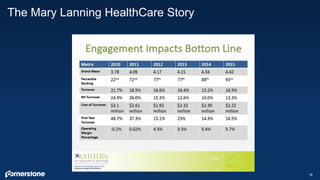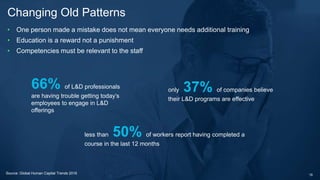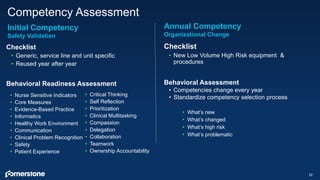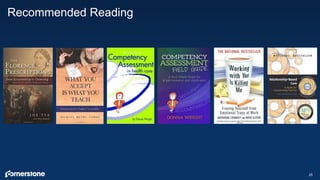Driving Engagement: The Link Between Staff Buy-in and Quality Care
- 1. Thomas Tonkin, Ph.D. and Lynn Howe RN. MS. CEN, CCRN Driving Engagement: The Link between Staff Buy-in and Quality Care
- 2. Thank You to All of Our Attendees!
- 3. Dr. Tom Tonkin Principal, Change Management and Transformation Thought Leadership & Advisory Services Dr. Tonkin is an executive in Professional Services and Software Sales arena and has over 25 years of business and technology experience.. Dr. Tonkin is also a speaker at leadership and business conferences where he also presents throughout the year. Today’s Speakers Lynn Howe RN. MS. CEN, CCRN Regional Sales Manager for Cornerstone Lynn has over 27 year of clinical experience ranging from Emergency Department Staff Nurse to Director of Clinical Education. She is board certified nurse for both Emergency and Critical Care.
- 4. What is Engagement anyway?
- 5. Employee engagement is a property of the relationship between an organization and its employees. An "engaged employee" is defined as one who is fully absorbed by and enthusiastic about their work and so takes positive action to further the organization's reputation and interests1. Employee engagement is a workplace approach resulting in the right conditions for all members of an organisation to give of their best each day, committed to their organisation’s goals and values, motivated to contribute to organisational success, with an enhanced sense of their own well- being3. Disengagement is a problem. A 2014 Gallup poll revealed only 31% of employees in the United States reported that they were engaged by their jobs in 2014. A full 51% were still “not engaged” and 17.5% were “actively disengaged. ”Disengagement refers to a lack of enthusiasm and commitment to work or a workplace2.
- 6. Intra-role behaviors that benefits the individual Example: Being Punctual Compliance Extra-role behaviors that benefits the organization Example: Helping others finish their work Altruism Engagement = Organizational Citizenship Behavior (OCB)4
- 7. • Conscientiousness - Conscientiousness refers to impersonal behavior that benefits the organization as a whole. • Sportsmanship - Sportsmanship is an employee’s willingness to deal with poor situations without complaining. • Courtesy - Courtesy is demonstrated by preventing organization problems through communication and general consideration for others. • Civic Virtue - Civic virtue is participating in the life and culture of the organization; this is not considered behavior that is targeted at individuals, rather, this behavior targets the organization. • Helping behavior - Helping behavior includes altruism, peacekeeping, and cheerleading. Revised View of OCBs5 7
- 8. Compliant Tasks • Task that are part of the job description. • These emanate with a motivation of “what I have to do” Altruistic Tasks • Tasks that are beyond the job description. • These emanate with a motivation of “what I want to do” OCBs as Tasks4 8
- 9. So, I can we motivate Altruistic Behaviors? 9
- 10. What happens before Altruistic behaviors?6 Altruistic Behaviors Job Satisfaction Perceived Fairness Person-Org Fit Leader’s Relationship
- 11. • Need for Achievement (Learning and Development growth path) • Leader Consideration (Good boss that listens) • Motivation (Want to do) Elements of Positive Job Satisfaction (Top 3)7 11 Job Satisfaction Learning and Development Growth Leader Consideration Motivation
- 12. Lynn Howe, Regional Sales Manager Engagement Outcome
- 13. Lynn has over 27 year of clinical experience ranging from Emergency Department Staff Nurse to Director of Clinical Education. She is board certified nurse for both Emergency and Critical Care. As an industry recognized expert Lynn offers healthcare organizations specific solution to advance both business and clinical outcomes by enhancing employee engagement, competency assessment and employee development strategies. In addition Lynn holds inept understanding of Joint Commission and Magnet standards Lynn holds an Associates Degree in Nursing from Beth Israel Medical Center, BSN from Alfred University and a MS. in Human Resource Management and Labor Relations from New York institute of Technology Lynn is now a Regional Sales Manager for Cornerstone. Lynn Howe RN. MS. CEN, CCRN 13
- 14. Medical Errors Now Third Leading Cause of Death in the U.S. 14
- 15. 15
- 16. The Mary Lanning HealthCare Story 16
- 17. • IOM to Err is Human • IOM Crossing the Quality Chasm • IOM Future of Nursing • AHRQ • Joint Commission • QSEN • Affordable Care Act The Interrelationship 17 ReimbursementEngagement Retention + Recruitment Safety Satisfaction Quality Outcomes Competency
- 18. • Did: • Education and training make a difference? • Employees incorporate the knowledge into daily practice? • Staff competency levels increase? • Training increase employee engagement? • Result in the outcomes we wanted? • Return on our investment? Ask – So What? 18
- 19. • One person made a mistake does not mean everyone needs additional training • Education is a reward not a punishment • Competencies must be relevant to the staff Changing Old Patterns 19 66% of L&D professionals are having trouble getting today’s employees to engage in L&D offerings only 37% of companies believe their L&D programs are effective less than 50% of workers report having completed a course in the last 12 months Source: Global Human Capital Trends 2016
- 20. • Competency is not achieved by: • Taking a test • Passing a course • Completing a checklist • Application not the acquisition of knowledge • Technical and behavioral competencies Engaging Competency Assessment 20
- 21. Require a sequence of steps followed in a specific order. 21 Checklist Application of knowledge in daily practice Behavioral Competencies • Demonstrates intuitive grasp of the clinical situation • Anticipates and observes for significant clinical cues indicating potential and actual deterioration in condition • Intuitively initiates appropriate course of action deemed appropriate for the situation • Request changes in physicians orders due to change in clinical condition • Measure the effectiveness of clinical interventions based on patient outcomes • Proactively asks out peer sand experts for assistance when need, including the rapid response team Clinical Problem Recognition
- 22. Checklist • Generic, service line and unit specific • Reused year after year Competency Assessment 22 Initial Competency Safety Validation • Nurse Sensitive Indicators • Core Measures • Evidence-Based Practice • Informatics • Healthy Work Environment • Communication • Clinical Problem Recognition • Safety • Patient Experience Behavioral Readiness Assessment Checklist • New Low Volume High Risk equipment & procedures Behavioral Assessment • Competencies change every year • Standardize competency selection process • What’s new • What’s changed • What’s high risk • What’s problematic Annual Competency Organizational Change • Critical Thinking • Self Reflection • Prioritization • Clinical Multitasking • Compassion • Delegation • Collaboration • Teamwork • Ownership Accountability
- 23. 23
- 24. • Enforces zero tolerance policy to address and eliminate abuse and disrespectful behavior in the workplace • Verbalizes commitment to accept personal responsibility for establishing and maintaining health interpersonal relationships based on equality and respect regardless of job titles or levels of educational preparation • Refuses to participate in a blame and shame culture of horizontal violence toward co-workers 2017 Focus on Safety and Engagement Competency 24 Engagement • Confidently and accurately anticipates potential changes in patients condition • Recognizes signs of early clinical deterioration • Proactively asks out peer and experts for assistance when need, including the rapid response team • Anticipates and requests changes in physician order due to changes in patients condition Critical Thinking • Adheres to organizational safety policies and procedures and lends support organizations effort to develop a culture of safety and quality patient care • Articulates department outcome data metrics reflect units success to provide high quality care • Utilize technology to keep the patient safe from harm • Comprehends errors and near misses to potentially prevent future errors • Encourages others to participate in organizational safety survey to improve patient safety at the unit level Safety
- 27. Thank You!
- 28. References 1. Employee engagement. (n.d.). Retrieved October 12, 2016, from https://en.wikipedia.org/wiki/Employee_engagement 2. @. (n.d.). What is Employee Engagement - Engage for Success. Retrieved October 14, 2016, from http://engageforsuccess.org/what-is-employee-engagement 3. Schaefer, L. (2015, May 12). Signs of Employee Disengagement and What To Do About It. Retrieved September 14, 2016, from http://www.skilledup.com/insights/signs-employee-disengagement 4. Smith, C. A., Organ, D. W., & Near, J. P. (1983). Organizational citizenship behavior: Its nature and antecedents. Journal of Applied Psychology, 68(4), 653-663. doi: 10.1037/0021-9010.68.4.653 5. Organ, D. W. (1988). Organizational citizenship behavior: the good soldier syndrome. (pp. 1-43). Lexington: Lexington Books. 6. Newland, Sarah J., "Organizational Citizenship Behavior- Individual or Organizational Citizenship Behavior- Organization: Does the Underlying Motive Matter?" (2012). Masters Theses & Specialist Projects. Paper 1159. http://digitalcommons.wku.edu/theses/1159 7. Baker WK. Antecedents and consequences of job satisfaction: Testing a comprehensive model using integrated methodology. Journal of Applied Business Research 2004;20(3):31 28
- 29. 29 Aiken, L. H., Cimiotti, J. P., Sloane, D. M., Smith, H. L. & Neff, D. F. (2011). Effects of nurse staffing and nurse education on patient deaths in hospitals with different nurse work environments. Medical Care, 49(12), 1047 – 53. Alliance for Continuing Education in the Health Professions: National Learning Competencies. Accessed at: http://www.acehp.org/iMIS15/aCME/Educate/National_Learning_Competencies/aCME/National_Learning_Competencies.aspx?hkey=43a904db-46f7-44ea-a89d-5973a7de3fc9 American Nurses Association and National Nursing Staff Development Organization (2010). Nursing Professional Development: Scope and Standards of Practice. Silver Spring, MD: Nursesbooks.org American Nurses Credentialing Center. Continuing Education Research Studies—July 2013. Accessed at http://www.nursecredentialing.org/Accreditation/ResourcesServices. Braithwaite, J., Westbrook, M., Nugus, P., Greenfield, D., Travaglia, J., Runciman, W., Foxwell, A. R., Boyce, R. A., Devinney, T. & Westbrook, J. (2012). A four-year, systems-wide intervention promoting interprofessional collaboration. BMC Health Services Research. Accessed at http://www.biomedcentral.com/1472-6963/12/99. Buljac-Samardzic, M., Dekker-van Doorn, C. M., van Wijngaarden, J. D. H. & van Wijk, K. P. (2010). Interventions to improve team effectiveness: A systematic review. Health Policy, 94, 183 – 195. Cohen, Henry Michael. What you Accept is What You Teach : Setting Standards for Employee Accountability 2013 Creative Health Care Management: Minneapolis MN Ferrell, B., McCabe, M., & Levit, L. (2013). The Institute of Medicine report on high-quality cancer care: Implications for oncology nursing. Oncology Nursing Forum, 40, 603–609. Institute of Medicine. (2001). Goldman, J., Zwarenstein, M., Bhattacharyya, O. & Reeves, S. (2009). Improving the Clarity of the Interprofessional Field: Implications for Research and Continuing Interprofessional Education. Journal of Continuing Education in the Health Professions, 29(3), 151 – 156. Gunter, M. J. (1999). The role of the ECHO model in outcomes research and clinical practice improvement. The American Journal of Managed Care, 5 (4 suppl), p. S217 - 24. Randolph, P., Hinton, J., Hagler, D., Mays, M., Kastenbaum, B., Brooks, R., . . . Weberg, D. (2012). Measuring competence: Collaboration for safety. Journal of Continuing Education in Nursing, 43, 541–547. Tyne, Joe., The Florence Prescription: From Accountability to Ownership Manifesto for a Positive Health Care Environment, 2009 Value Coach Wright, Donna. The Ultimate Guide to Competency Assessment in Healthcare 2005 Creative Health Care Management: Minneapolis MN Wright, Donna. Competency Assessment Field Guide A Real Work Guide for Implmentation and Application. 2014 Creative Health Care Management: Minneapolis MN
Editor's Notes
- Talking Points: One of the keys to maintaining your organization’s competitive edge is through workforce learning, but are you enabling your workforce with information when they need it? And is L&D aligned with your business objectives? The Millennial workforce is changing jobs frequently, and Baby Boomers are leaving the workforce faster than organizations have time to replace them. Thus, it’s crucial to reduce ramp times, shorten the learning curve, and accelerate learning to drive greater productivity and reduce knowledge drain. 66% of L&D professionals are having trouble getting employees to engage with L&D offerings. To drive engagement and promote continuous learning, L&D is having to change the way they do things. Learning needs to be contextual, just-in-time, and integrated into workflows.
- Talking Points: One of the keys to maintaining your organization’s competitive edge is through workforce learning, but are you enabling your workforce with information when they need it? And is L&D aligned with your business objectives? The Millennial workforce is changing jobs frequently, and Baby Boomers are leaving the workforce faster than organizations have time to replace them. Thus, it’s crucial to reduce ramp times, shorten the learning curve, and accelerate learning to drive greater productivity and reduce knowledge drain. 66% of L&D professionals are having trouble getting employees to engage with L&D offerings. To drive engagement and promote continuous learning, L&D is having to change the way they do things. Learning needs to be contextual, just-in-time, and integrated into workflows.
- Talking Points: One of the keys to maintaining your organization’s competitive edge is through workforce learning, but are you enabling your workforce with information when they need it? And is L&D aligned with your business objectives? The Millennial workforce is changing jobs frequently, and Baby Boomers are leaving the workforce faster than organizations have time to replace them. Thus, it’s crucial to reduce ramp times, shorten the learning curve, and accelerate learning to drive greater productivity and reduce knowledge drain. 66% of L&D professionals are having trouble getting employees to engage with L&D offerings. To drive engagement and promote continuous learning, L&D is having to change the way they do things. Learning needs to be contextual, just-in-time, and integrated into workflows.
- Talking Points: One of the keys to maintaining your organization’s competitive edge is through workforce learning, but are you enabling your workforce with information when they need it? And is L&D aligned with your business objectives? The Millennial workforce is changing jobs frequently, and Baby Boomers are leaving the workforce faster than organizations have time to replace them. Thus, it’s crucial to reduce ramp times, shorten the learning curve, and accelerate learning to drive greater productivity and reduce knowledge drain. 66% of L&D professionals are having trouble getting employees to engage with L&D offerings. To drive engagement and promote continuous learning, L&D is having to change the way they do things. Learning needs to be contextual, just-in-time, and integrated into workflows.
- Talking Points: One of the keys to maintaining your organization’s competitive edge is through workforce learning, but are you enabling your workforce with information when they need it? And is L&D aligned with your business objectives? The Millennial workforce is changing jobs frequently, and Baby Boomers are leaving the workforce faster than organizations have time to replace them. Thus, it’s crucial to reduce ramp times, shorten the learning curve, and accelerate learning to drive greater productivity and reduce knowledge drain. 66% of L&D professionals are having trouble getting employees to engage with L&D offerings. To drive engagement and promote continuous learning, L&D is having to change the way they do things. Learning needs to be contextual, just-in-time, and integrated into workflows.
- Talking Points: One of the keys to maintaining your organization’s competitive edge is through workforce learning, but are you enabling your workforce with information when they need it? And is L&D aligned with your business objectives? The Millennial workforce is changing jobs frequently, and Baby Boomers are leaving the workforce faster than organizations have time to replace them. Thus, it’s crucial to reduce ramp times, shorten the learning curve, and accelerate learning to drive greater productivity and reduce knowledge drain. 66% of L&D professionals are having trouble getting employees to engage with L&D offerings. To drive engagement and promote continuous learning, L&D is having to change the way they do things. Learning needs to be contextual, just-in-time, and integrated into workflows.
- Talking Points: One of the keys to maintaining your organization’s competitive edge is through workforce learning, but are you enabling your workforce with information when they need it? And is L&D aligned with your business objectives? The Millennial workforce is changing jobs frequently, and Baby Boomers are leaving the workforce faster than organizations have time to replace them. Thus, it’s crucial to reduce ramp times, shorten the learning curve, and accelerate learning to drive greater productivity and reduce knowledge drain. 66% of L&D professionals are having trouble getting employees to engage with L&D offerings. To drive engagement and promote continuous learning, L&D is having to change the way they do things. Learning needs to be contextual, just-in-time, and integrated into workflows.
- Talking Points: One of the keys to maintaining your organization’s competitive edge is through workforce learning, but are you enabling your workforce with information when they need it? And is L&D aligned with your business objectives? The Millennial workforce is changing jobs frequently, and Baby Boomers are leaving the workforce faster than organizations have time to replace them. Thus, it’s crucial to reduce ramp times, shorten the learning curve, and accelerate learning to drive greater productivity and reduce knowledge drain. 66% of L&D professionals are having trouble getting employees to engage with L&D offerings. To drive engagement and promote continuous learning, L&D is having to change the way they do things. Learning needs to be contextual, just-in-time, and integrated into workflows.
- Talking Points: One of the keys to maintaining your organization’s competitive edge is through workforce learning, but are you enabling your workforce with information when they need it? And is L&D aligned with your business objectives? The Millennial workforce is changing jobs frequently, and Baby Boomers are leaving the workforce faster than organizations have time to replace them. Thus, it’s crucial to reduce ramp times, shorten the learning curve, and accelerate learning to drive greater productivity and reduce knowledge drain. 66% of L&D professionals are having trouble getting employees to engage with L&D offerings. To drive engagement and promote continuous learning, L&D is having to change the way they do things. Learning needs to be contextual, just-in-time, and integrated into workflows.
- Talking Points: One of the keys to maintaining your organization’s competitive edge is through workforce learning, but are you enabling your workforce with information when they need it? And is L&D aligned with your business objectives? The Millennial workforce is changing jobs frequently, and Baby Boomers are leaving the workforce faster than organizations have time to replace them. Thus, it’s crucial to reduce ramp times, shorten the learning curve, and accelerate learning to drive greater productivity and reduce knowledge drain. 66% of L&D professionals are having trouble getting employees to engage with L&D offerings. To drive engagement and promote continuous learning, L&D is having to change the way they do things. Learning needs to be contextual, just-in-time, and integrated into workflows.
- Talking Points: One of the keys to maintaining your organization’s competitive edge is through workforce learning, but are you enabling your workforce with information when they need it? And is L&D aligned with your business objectives? The Millennial workforce is changing jobs frequently, and Baby Boomers are leaving the workforce faster than organizations have time to replace them. Thus, it’s crucial to reduce ramp times, shorten the learning curve, and accelerate learning to drive greater productivity and reduce knowledge drain. 66% of L&D professionals are having trouble getting employees to engage with L&D offerings. To drive engagement and promote continuous learning, L&D is having to change the way they do things. Learning needs to be contextual, just-in-time, and integrated into workflows.
- Talking Points: One of the keys to maintaining your organization’s competitive edge is through workforce learning, but are you enabling your workforce with information when they need it? And is L&D aligned with your business objectives? The Millennial workforce is changing jobs frequently, and Baby Boomers are leaving the workforce faster than organizations have time to replace them. Thus, it’s crucial to reduce ramp times, shorten the learning curve, and accelerate learning to drive greater productivity and reduce knowledge drain. 66% of L&D professionals are having trouble getting employees to engage with L&D offerings. To drive engagement and promote continuous learning, L&D is having to change the way they do things. Learning needs to be contextual, just-in-time, and integrated into workflows.
- Talking Points: One of the keys to maintaining your organization’s competitive edge is through workforce learning, but are you enabling your workforce with information when they need it? And is L&D aligned with your business objectives? The Millennial workforce is changing jobs frequently, and Baby Boomers are leaving the workforce faster than organizations have time to replace them. Thus, it’s crucial to reduce ramp times, shorten the learning curve, and accelerate learning to drive greater productivity and reduce knowledge drain. 66% of L&D professionals are having trouble getting employees to engage with L&D offerings. To drive engagement and promote continuous learning, L&D is having to change the way they do things. Learning needs to be contextual, just-in-time, and integrated into workflows.





























